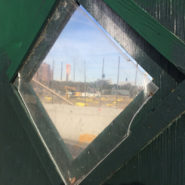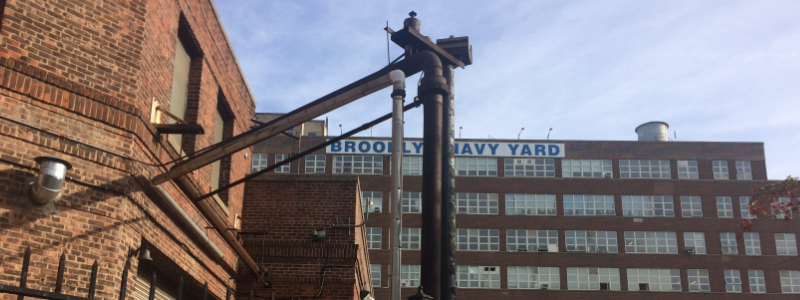
Sometimes a character grabs hold of me and insists on dragging me around the country to teach me about their backstory. That’s how I wound up in New York State last fall, poking around in the world of my novel in progress. I’d like to share, in a series of blog posts, some of what I found out. Today’s topic: the Brooklyn Navy Yard, a.k.a. “the Can-Do Yard”–and, specifically, what it has to do with my characters’ history, and mine.

Seamus, the fictional great-great-grandfather in my work in progress, was an Irish-American street urchin turned war hero. His own great-great-grandparents came across in the holds of coffin ships during the Great Hunger and settled in the Brooklyn neighborhood now known as Vinegar Hill.
(Aside: Yes, parents and grandparents and great-great-grandparents figure large in We Still Have Us, even when they never even make it onto the page. Isn’t that true in real life, too?)
Let’s get back to Seamus. Before the age of ten, he was hustling for odd jobs to help out with his family’s upkeep. He swept sidewalks, delivered groceries, and used his wiles to stay alive on the streets of New York. The men in his family found day work at the Navy Yard, so it was a given that Seamus would end up apprenticing there by his fifteenth birthday. With his lean, wiry frame, he could easily wriggle into tight spaces in the bowels of ships. He did the work that countless tradesmen–pipefitters, electricians, welders–performed to build the ships that kept not only the Navy but the economy afloat–and that enabled the Allied victory in World War II.
A modest man (although not unreasonably so–after all, that would be ridiculous for a man of his charms), Seamus soon caught the eye of young Rose Brennan, who’d been sent down from upstate after her mother’s death to be raised by relatives in Brooklyn. Seamus and Rose courted and wed.
But after Pearl Harbor, Seamus enlisted in the Navy, while Rose and thousands of women like her stepped up to fill the jobs vacated by their men.
(Aside: Never fear–women’s role at the Can-Do Yard will be the subject of a future post in this series!)
So there we have the bare outlines of those two characters’ backstory. Seamus and Rose, long gone by the time We Still Have Us opens in 2008, nevertheless hover over the proceedings, at least in my main character’s subconscious. An early chapter in the book, in which my MC breaks into her great-grandparents’ abandoned house, is titled “Here Be Ghosts.” No, it’s not a ghost story–not in that sense. But, yes–spirits live, and influence the story.
They certainly influence me. I never met my maternal grandfather, who died long before I was born. And I didn’t have enough years with my maternal grandmother, who crossed the Atlantic in 1909, got horribly ill in the squalid conditions belowdecks, and was immediately sent to the hospital upon disembarking in New York. She was lucky to be admitted into the care of her aunties when she recovered, rather than sent back to Ireland. If things had gone the other way, I’d be speaking with a brogue today–which would be lovely, but it wasn’t Grandma’s plan. She chose to come to America.
I’d known a little bit about my grandmother’s journey since I was a child, but she didn’t really start to speak to me until I began work on this novel. Readers always want to know if a certain character is really such-and-such a person in real life. I think, almost always, the answer is no. Certainly, for me, the answer is always no (so rest easy, friends and family!). But, at a deeper level, a compelling character doesn’t come to life unless he or she has a deep connection with the writer–even if the writer is at a loss to explain why.
At any rate, the ghosts of my own ancestors, as well as those of my main character’s ancestors, eventually became so compelling that I really didn’t have a choice. I had to get on a plane, then a train, then a bus, and take a tour of the Brooklyn Navy Yard. I’m glad I did–so thanks, ancestors!
And now that I’ve laid the groundwork, the “why” of this series of posts, I’ll be back next week with another installment in the story. The Can-Do Yard brought up so many feelings and ideas, all of which tie into my writing in one way or another, and I can’t wait to share them with you.
My current work in progress, We Still Have Us, tells the story of a seventeen-year-old girl in upstate New York who’s caught between poverty and privilege, dreams and duty, past and future. You can read more about it here. And for writerly updates, news, and commentary, subscribe below to my newsletter.

0 Comments
Trackbacks/Pingbacks